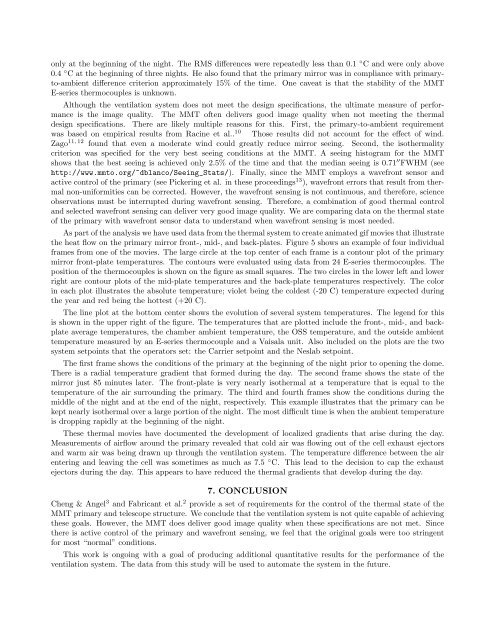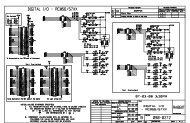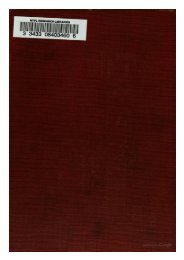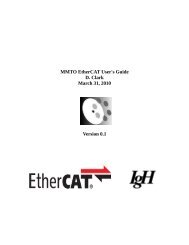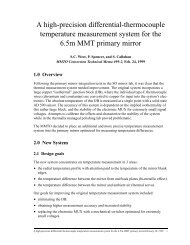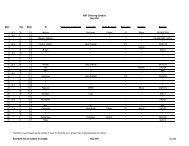Performance and control of the MMT thermal system
Performance and control of the MMT thermal system
Performance and control of the MMT thermal system
You also want an ePaper? Increase the reach of your titles
YUMPU automatically turns print PDFs into web optimized ePapers that Google loves.
only at <strong>the</strong> beginning <strong>of</strong> <strong>the</strong> night. The RMS differences were repeatedly less than 0.1 ◦ C <strong>and</strong> were only above0.4 ◦ C at <strong>the</strong> beginning <strong>of</strong> three nights. He also found that <strong>the</strong> primary mirror was in compliance with primaryto-ambientdifference criterion approximately 15% <strong>of</strong> <strong>the</strong> time. One caveat is that <strong>the</strong> stability <strong>of</strong> <strong>the</strong> <strong>MMT</strong>E-series <strong>the</strong>rmocouples is unknown.Although <strong>the</strong> ventilation <strong>system</strong> does not meet <strong>the</strong> design specifications, <strong>the</strong> ultimate measure <strong>of</strong> performanceis <strong>the</strong> image quality. The <strong>MMT</strong> <strong>of</strong>ten delivers good image quality when not meeting <strong>the</strong> <strong>the</strong>rmaldesign specifications. There are likely multiple reasons for this. First, <strong>the</strong> primary-to-ambient requirementwas based on empirical results from Racine et al.. 10 Those results did not account for <strong>the</strong> effect <strong>of</strong> wind.Zago 11, 12 found that even a moderate wind could greatly reduce mirror seeing. Second, <strong>the</strong> iso<strong>the</strong>rmalitycriterion was specified for <strong>the</strong> very best seeing conditions at <strong>the</strong> <strong>MMT</strong>. A seeing histogram for <strong>the</strong> <strong>MMT</strong>shows that <strong>the</strong> best seeing is achieved only 2.5% <strong>of</strong> <strong>the</strong> time <strong>and</strong> that <strong>the</strong> median seeing is 0.71 ′′ FWHM (seehttp://www.mmto.org/~dblanco/Seeing_Stats/). Finally, since <strong>the</strong> <strong>MMT</strong> employs a wavefront sensor <strong>and</strong>active <strong>control</strong> <strong>of</strong> <strong>the</strong> primary (see Pickering et al. in <strong>the</strong>se proceedings 13 ), wavefront errors that result from <strong>the</strong>rmalnon-uniformities can be corrected. However, <strong>the</strong> wavefront sensing is not continuous, <strong>and</strong> <strong>the</strong>refore, scienceobservations must be interrupted during wavefront sensing. Therefore, a combination <strong>of</strong> good <strong>the</strong>rmal <strong>control</strong><strong>and</strong> selected wavefront sensing can deliver very good image quality. We are comparing data on <strong>the</strong> <strong>the</strong>rmal state<strong>of</strong> <strong>the</strong> primary with wavefront sensor data to underst<strong>and</strong> when wavefront sensing is most needed.As part <strong>of</strong> <strong>the</strong> analysis we have used data from <strong>the</strong> <strong>the</strong>rmal <strong>system</strong> to create animated gif movies that illustrate<strong>the</strong> heat flow on <strong>the</strong> primary mirror front-, mid-, <strong>and</strong> back-plates. Figure 5 shows an example <strong>of</strong> four individualframes from one <strong>of</strong> <strong>the</strong> movies. The large circle at <strong>the</strong> top center <strong>of</strong> each frame is a contour plot <strong>of</strong> <strong>the</strong> primarymirror front-plate temperatures. The contours were evaluated using data from 24 E-series <strong>the</strong>rmocouples. Theposition <strong>of</strong> <strong>the</strong> <strong>the</strong>rmocouples is shown on <strong>the</strong> figure as small squares. The two circles in <strong>the</strong> lower left <strong>and</strong> lowerright are contour plots <strong>of</strong> <strong>the</strong> mid-plate temperatures <strong>and</strong> <strong>the</strong> back-plate temperatures respectively. The colorin each plot illustrates <strong>the</strong> absolute temperature; violet being <strong>the</strong> coldest (-20 C) temperature expected during<strong>the</strong> year <strong>and</strong> red being <strong>the</strong> hottest (+20 C).The line plot at <strong>the</strong> bottom center shows <strong>the</strong> evolution <strong>of</strong> several <strong>system</strong> temperatures. The legend for thisis shown in <strong>the</strong> upper right <strong>of</strong> <strong>the</strong> figure. The temperatures that are plotted include <strong>the</strong> front-, mid-, <strong>and</strong> backplateaverage temperatures, <strong>the</strong> chamber ambient temperature, <strong>the</strong> OSS temperature, <strong>and</strong> <strong>the</strong> outside ambienttemperature measured by an E-series <strong>the</strong>rmocouple <strong>and</strong> a Vaisala unit. Also included on <strong>the</strong> plots are <strong>the</strong> two<strong>system</strong> setpoints that <strong>the</strong> operators set: <strong>the</strong> Carrier setpoint <strong>and</strong> <strong>the</strong> Neslab setpoint.The first frame shows <strong>the</strong> conditions <strong>of</strong> <strong>the</strong> primary at <strong>the</strong> beginning <strong>of</strong> <strong>the</strong> night prior to opening <strong>the</strong> dome.There is a radial temperature gradient that formed during <strong>the</strong> day. The second frame shows <strong>the</strong> state <strong>of</strong> <strong>the</strong>mirror just 85 minutes later. The front-plate is very nearly iso<strong>the</strong>rmal at a temperature that is equal to <strong>the</strong>temperature <strong>of</strong> <strong>the</strong> air surrounding <strong>the</strong> primary. The third <strong>and</strong> fourth frames show <strong>the</strong> conditions during <strong>the</strong>middle <strong>of</strong> <strong>the</strong> night <strong>and</strong> at <strong>the</strong> end <strong>of</strong> <strong>the</strong> night, respectively. This example illustrates that <strong>the</strong> primary can bekept nearly iso<strong>the</strong>rmal over a large portion <strong>of</strong> <strong>the</strong> night. The most difficult time is when <strong>the</strong> ambient temperatureis dropping rapidly at <strong>the</strong> beginning <strong>of</strong> <strong>the</strong> night.These <strong>the</strong>rmal movies have documented <strong>the</strong> development <strong>of</strong> localized gradients that arise during <strong>the</strong> day.Measurements <strong>of</strong> airflow around <strong>the</strong> primary revealed that cold air was flowing out <strong>of</strong> <strong>the</strong> cell exhaust ejectors<strong>and</strong> warm air was being drawn up through <strong>the</strong> ventilation <strong>system</strong>. The temperature difference between <strong>the</strong> airentering <strong>and</strong> leaving <strong>the</strong> cell was sometimes as much as 7.5 ◦ C. This lead to <strong>the</strong> decision to cap <strong>the</strong> exhaustejectors during <strong>the</strong> day. This appears to have reduced <strong>the</strong> <strong>the</strong>rmal gradients that develop during <strong>the</strong> day.7. CONCLUSIONCheng & Angel 3 <strong>and</strong> Fabricant et al. 2 provide a set <strong>of</strong> requirements for <strong>the</strong> <strong>control</strong> <strong>of</strong> <strong>the</strong> <strong>the</strong>rmal state <strong>of</strong> <strong>the</strong><strong>MMT</strong> primary <strong>and</strong> telescope structure. We conclude that <strong>the</strong> ventilation <strong>system</strong> is not quite capable <strong>of</strong> achieving<strong>the</strong>se goals. However, <strong>the</strong> <strong>MMT</strong> does deliver good image quality when <strong>the</strong>se specifications are not met. Since<strong>the</strong>re is active <strong>control</strong> <strong>of</strong> <strong>the</strong> primary <strong>and</strong> wavefront sensing, we feel that <strong>the</strong> original goals were too stringentfor most “normal” conditions.This work is ongoing with a goal <strong>of</strong> producing additional quantitative results for <strong>the</strong> performance <strong>of</strong> <strong>the</strong>ventilation <strong>system</strong>. The data from this study will be used to automate <strong>the</strong> <strong>system</strong> in <strong>the</strong> future.


